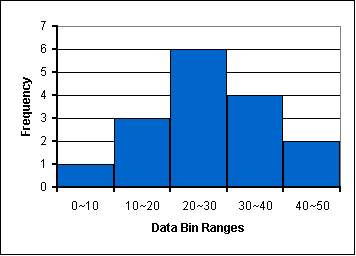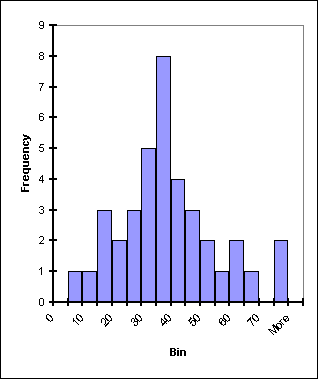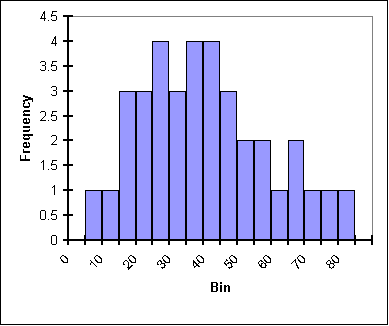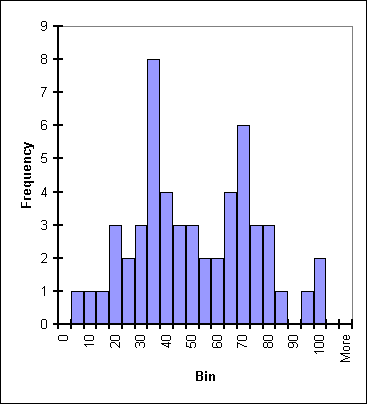 |
Histograms: Construction, Analysis and Understanding |
 |
Conservation Laws - Data Analysis Using Graphs - Histograms - Units or Vectors in Particle Physics
|
What is a Histogram? A histogram is "a representation of a frequency distribution by means of rectangles whose widths represent class intervals and whose areas are proportional to the corresponding frequencies." Online Webster's Dictionary
Sounds complicated . . . but the concept really is pretty simple. We graph groups of numbers according to how often they appear. Thus if we have the set {1,2,2,3,3,3,3,4,4,5,6}, we can graph them like this:
|

| ||||||||||||
|
How is a Real Histogram Made? The example above is a little too simple. In most real data sets almost all numbers will be unique. Consider the set {3, 11, 12, 19, 22, 23, 24, 25, 27, 29, 35, 36, 37, 45, 49}. A graph which shows how many ones, how many twos, how many threes, etc. would be meaningless. Instead we bin the data into convenient ranges. In this case, with a bin width of 10, we can easily group the data as below. Note: Changing the size of the bin changes the apprearance of the graph and the conclusions you may draw from it. The Shodor histogram activity allows you to change the bin size for a data set and the impact on the curve. | |||||||||||||
Note that the median is 25 and that there is no mode; the mean is 26.5. |
 | ||||||||||||
How Shall We Look at Histograms?
Of course, part of the power of histograms is that they allow us to analyze extremely large datasets by reducing them to a single graph that can show primary, secondary and tertiary peaks in data as well as give a visual representation of the statistical significance of those peaks. To get an idea, look at these three histograms:
 |
 |
| This plot represents data with a well-defined peak that is close in value to the median and the mean. While there are "outlyers," they are of relatively low frequency. Thus it can be said that deviations in this data group from the mean are of low frequency. If this were a mass plot in particle physics, we'd say the mass is understood with good precision. | In this plot the peak is still fairly close to the median and the mean but it is much less defined. It is harder to tell from the plot what the exact location of the peak is. There are almost as many values close to the peak as at the peak itself and outlyers are frequent. As a particle physics mass plot, this gives an imprecise and undertain mass of a particle. |
 |
Where are the median and the mean? It is hard to tell; it also may not be relevant. There are two peaks in this plot: a taller primary peak as well as a shorter secondary peak. This could indicate either very poor definition of one signal in the data or, more likely, two signals. In particle physics, this could show two separate particles or, as is often the case, a large signal with "background" particles and a smaller signal (sometimes very small), called a "bump," which shows the actual particle under study. |
- Sample Histogram - This is another example of how a histogram is made, with a focus on the effect of bin size.
- Shodor Histogram Page - This is a nice interactive histogram page in which you can choose different sample histograms and vary the bin size.
- Excel Help - To work with large datasets, it helps to use a spreadsheet. This tutorial walks you through the process of making a histogram in MS Excel.
- Histogram Problems - These are practice problems (with solutions) so that you can construct and analyze histograms on your own.